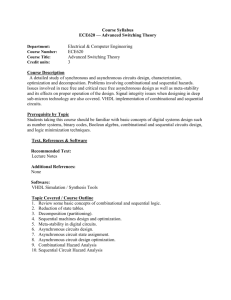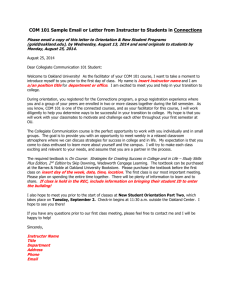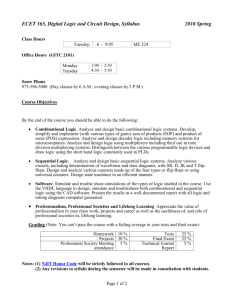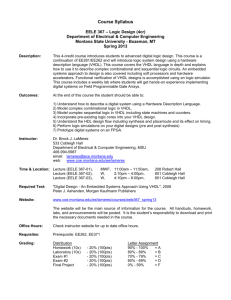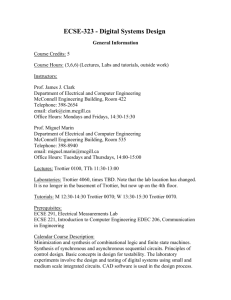Syllabus - Oakland University
advertisement
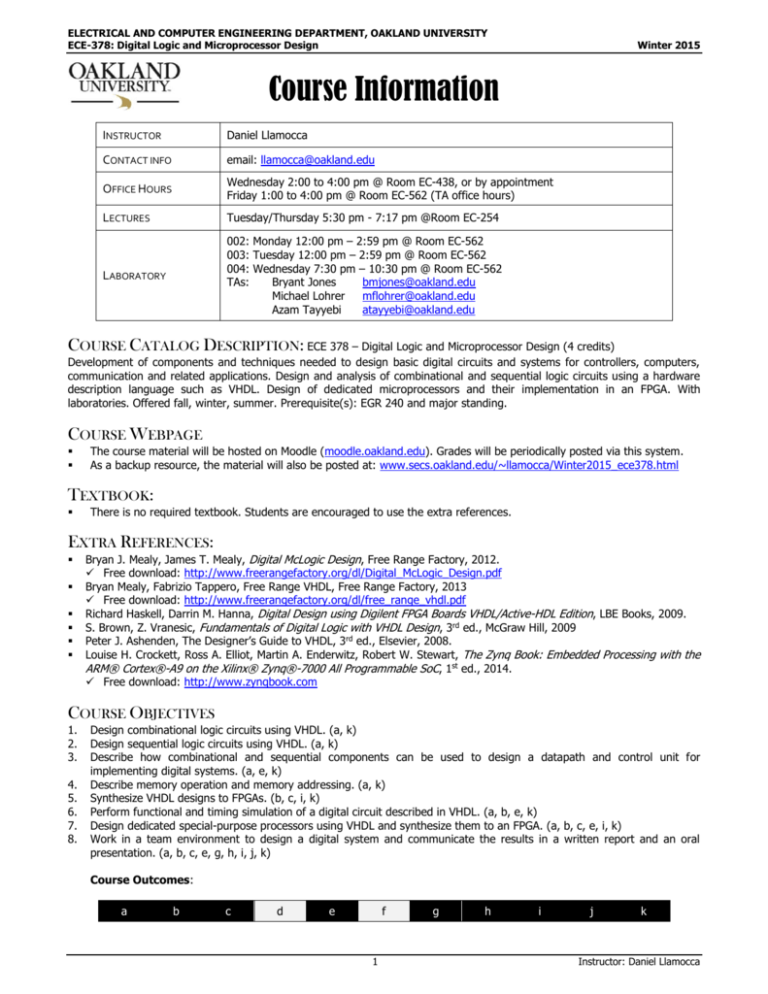
ELECTRICAL AND COMPUTER ENGINEERING DEPARTMENT, OAKLAND UNIVERSITY ECE-378: Digital Logic and Microprocessor Design Winter 2015 Course Information INSTRUCTOR Daniel Llamocca CONTACT INFO email: llamocca@oakland.edu OFFICE HOURS Wednesday 2:00 to 4:00 pm @ Room EC-438, or by appointment Friday 1:00 to 4:00 pm @ Room EC-562 (TA office hours) LECTURES Tuesday/Thursday 5:30 pm - 7:17 pm @Room EC-254 LABORATORY 002: Monday 12:00 pm – 2:59 pm @ Room EC-562 003: Tuesday 12:00 pm – 2:59 pm @ Room EC-562 004: Wednesday 7:30 pm – 10:30 pm @ Room EC-562 TAs: Bryant Jones bmjones@oakland.edu Michael Lohrer mflohrer@oakland.edu Azam Tayyebi atayyebi@oakland.edu COURSE CATALOG DESCRIPTION: ECE 378 – Digital Logic and Microprocessor Design (4 credits) Development of components and techniques needed to design basic digital circuits and systems for controllers, computers, communication and related applications. Design and analysis of combinational and sequential logic circuits using a hardware description language such as VHDL. Design of dedicated microprocessors and their implementation in an FPGA. With laboratories. Offered fall, winter, summer. Prerequisite(s): EGR 240 and major standing. COURSE WEBPAGE The course material will be hosted on Moodle (moodle.oakland.edu). Grades will be periodically posted via this system. As a backup resource, the material will also be posted at: www.secs.oakland.edu/~llamocca/Winter2015_ece378.html TEXTBOOK: There is no required textbook. Students are encouraged to use the extra references. EXTRA REFERENCES: Bryan J. Mealy, James T. Mealy, Digital McLogic Design, Free Range Factory, 2012. Free download: http://www.freerangefactory.org/dl/Digital_McLogic_Design.pdf Bryan Mealy, Fabrizio Tappero, Free Range VHDL, Free Range Factory, 2013 Free download: http://www.freerangefactory.org/dl/free_range_vhdl.pdf Richard Haskell, Darrin M. Hanna, Digital Design using Digilent FPGA Boards VHDL/Active-HDL Edition, LBE Books, 2009. S. Brown, Z. Vranesic, Fundamentals of Digital Logic with VHDL Design, 3rd ed., McGraw Hill, 2009 Peter J. Ashenden, The Designer’s Guide to VHDL, 3rd ed., Elsevier, 2008. Louise H. Crockett, Ross A. Elliot, Martin A. Enderwitz, Robert W. Stewart, The Zynq Book: Embedded Processing with the ARM® Cortex®-A9 on the Xilinx® Zynq®-7000 All Programmable SoC, 1st ed., 2014. Free download: http://www.zynqbook.com COURSE OBJECTIVES 1. 2. 3. 4. 5. 6. 7. 8. Design combinational logic circuits using VHDL. (a, k) Design sequential logic circuits using VHDL. (a, k) Describe how combinational and sequential components can be used to design a datapath and control unit for implementing digital systems. (a, e, k) Describe memory operation and memory addressing. (a, k) Synthesize VHDL designs to FPGAs. (b, c, i, k) Perform functional and timing simulation of a digital circuit described in VHDL. (a, b, e, k) Design dedicated special-purpose processors using VHDL and synthesize them to an FPGA. (a, b, c, e, i, k) Work in a team environment to design a digital system and communicate the results in a written report and an oral presentation. (a, b, c, e, g, h, i, j, k) Course Outcomes: a b c d e f 1 g h i j k Instructor: Daniel Llamocca ELECTRICAL AND COMPUTER ENGINEERING DEPARTMENT, OAKLAND UNIVERSITY ECE-378: Digital Logic and Microprocessor Design Winter 2015 GRADING SCHEME: 15% 20% (February 19th, 5:30-7:17 pm) 20% (April 23rd, 7:00-10:00 pm) Homeworks: Homework assignments are meant to strengthen your conceptual understanding of the topics. Completing homework assignments is a key component of this course as it will help students master the course material and prepare them for the exams. Homeworks will be posted according to the schedule (green rectangles). Students have one week to turn in the completed assignments in class. Late submissions are NOT accepted. Schedule Su Mo Tu We Th Fr Sa 1 2 3 Lab 1 Quiz 1 Quizzes: They will have a duration of 20 minutes at the beginning of the class. Quiz 2 Lab 3 5 6 7 8 9 10 18 19 20 21 22 23 24 1 2 3 4 5 6 Lab 4 Quiz 3 Lab 5 HW 2 7 8 9 10 11 12 13 14 Midterm 15 16 17 18 19 20 21 22 23 24 25 26 27 28 Laboratory: This important component of the class will reinforce your understanding of the topics. There will be six (6) labs throughout the semester. TAs will be present every week during the regularly scheduled laboratory times. Students can work during those times or at any other time and place. Students have one week to complete the lab assignments and have them checked off by the TA. HW 1 11 12 13 14 15 16 17 25 26 27 28 29 30 31 Lab 2 Exams: Closed-books, closed-notes, in-class exams. The final exam will be a comprehensive test that will cover the whole syllabus. Students are not allowed to take the exams neither before nor after the exam date. Make-up exams are given only under extreme circumstances (such as a medical emergency). 1 2 3 4 5 6 8 9 10 11 12 13 14 HW 3 7 15 16 17 18 19 20 21 HW 4 22 23 24 25 26 27 28 29 30 31 Lab 6 Final Project: Students will work in groups in a Final Project. Each group will prepare an oral presentation and submit a final report. Presentations will take place on April 14th and April 16th. 5 Quiz 4 GRADE ASSIGNMENT: 90-100 80-89 60-79 50-59 49 and below January 4 February Final Project: Midterm Exam: Final Exam: April 15% 10% 20% March Homeworks: Quizzes: Laboratory: 6 7 1 2 3 4 8 9 10 11 12 13 14 15 16 17 18 Final Project Presentation 19 20 21 22 23 24 25 26 27 28 29 30 Final Exam 3.6 to 4.0 (A) 3.0 to 3.5 (B) 2.0 to 2.9 (C) 1.0 to 1.9 (D) 0.0 (no credit) LABORATORY MATERIALS Hardware: NexysTM-4 Artix-7 FPGA Board To order the board: http://www.digilentinc.com/Products/Detail.cfm?Prod=NEXYS4 Select the Academic Version Software: Xilinx® ISE Webpack Design Software 14.7 version: To download: http://www.xilinx.com/support/download/index.html/content/xilinx/en/downloadNav/design-tools.html 2 Instructor: Daniel Llamocca ELECTRICAL AND COMPUTER ENGINEERING DEPARTMENT, OAKLAND UNIVERSITY ECE-378: Digital Logic and Microprocessor Design Winter 2015 OUTLINE OF TOPICS Introduction to Logic Circuits Optimized Implementation of Logic Functions Implementation Technology Number Systems and Computer Arithmetic Combinational Circuits Synchronous Sequential Circuits Introduction to Digital System Design Boolean Algebra Sum-of-Products and Product-of-Sums forms Logic Gates. Timing diagrams Basic Techniques Karnaugh Maps Quine-McCluskey algorithm Logic Levels, CMOS Logic gates Tri-state buffers, Transmission Gates Practical aspects: propagation delay, noise margin, hazards Programmable Logic Devices, Field Programmable Gate Arrays Binary representation Unsigned Octal and hexadecimal representation integer numbers Addition and subtraction Signed integer Binary representation numbers Addition and subtraction Multiplication of Array multiplier for unsigned numbers integer numbers Multiplication of signed numbers Binary Codes Introduction to Fixed-point arithmetic Multiplexers, De-multiplexers Decoders, Encoders, Comparators Basic circuits Code Converters: BCD to 7-segment, Gray to BCD, etc. Parity generators and parity checkers Look-up Tables Complex circuits Arithmetic Logic Unit (ALU) Design Barrel shifter Flip flops and latches Registers, shift registers Basic circuits Parallel access shift registers: parallel-to-serial/serial-to-parallel conversion Counters: synchronous, BCD, Ring, Johnson Random Access Memory Moore and Mealy state Models Finite State Design Steps: State Diagram, State Table, State assignments. Machines (FSMs) Algorithmic State Machine (ASM) charts Digital system (or special-purpose processor) components: Datapath circuit, Control Circuit Design examples: Small processor, shift-and-add multiplier, multiply-and-accumulate (MAC) circuit, etc. VHDL: For every topic, an aspect of VHDL description will be explored. Introduction Concurrent Description Behavioral Description Structural Description Sequential Circuits Parameterization Design Flow: Design Entry, Functional Simulation, Mapping, Timing Simulation, Implementation Data Types VHDL Description: Logic Gates VHDL Testbench Generation Concurrent statements: ‘with-select’, ‘when-else’ Combinational circuits description: (priority) encoder, decoder, comparator, mux, de-mux. Asynchronous processes Behavioral description of Combinational circuits: (priority) encoder, decoder, comparator, mux. Sequential statements: ‘if-else’, ‘case’, ‘for-loop’ Hierarchical design: Use of port-map, for-generate, if-generate. Examples: Adder, multiplier, Arithmetic Logic Unit, Look-up Table Testbench: generating clock stimulus Asynchronous processes: Latches Synchronous processes: flip-flops, counters, registers Description of Finite State Machines Simple techniques Use of for-generate, if-generate, arrays in VHDL. 3 Instructor: Daniel Llamocca ELECTRICAL AND COMPUTER ENGINEERING DEPARTMENT, OAKLAND UNIVERSITY ECE-378: Digital Logic and Microprocessor Design Winter 2015 CLASS POLICIES Laboratory: Students must be aware of their Laboratory section: 002, 003, 004. This will be used to determine whether a student is late in their laboratory submission. Students are advised to attend on the day of their respective Laboratory Section. However, students can attend any other Laboratory Section if there is space available. Students will be able to complete a TA evaluation form at the end of the semester. Academic conduct policy: All members of the academic community at Oakland University are expected to practice and uphold standards of academic integrity and honesty. Academic integrity means representing oneself and one’s work honestly. Misrepresentation is cheating since it means students are claiming credit for ideas or work not actually theirs and are thereby seeking a grade that is not actually learned. Academic dishonesty will be dealt with seriously and appropriately. Academic dishonesty includes, but it is not limited to cheating on examinations, plagiarizing the works of others, cheating on lab reports, unauthorized collaboration in assignments, hindering the academic work of other students. Special Considerations: Students with disabilities who may require special consideration should make an appointment with campus Disability Support Services, 106 North Foundation Hall, phone 248 370-3266. Students should also bring their needs to the attention of the instructor as soon as possible. For academic help, such as study and reading skills, contact the Academic Skills/Tutoring Center, 103 North Foundation Hall, phone 248 370-4215. Add/Drops: The university policy will be explicitly followed. It is the student’s responsibility to be aware of deadline dates for dropping courses. Attendance: It is assumed that the students are aware of and understand the university attendance policy. Attendance is mandatory and maybe monitored. Students are responsible for all material covered in classes that they miss. There will no excuses for being late to quizzes/exams. Athlete Excused Absences: Students shall inform the instructor of dates they will miss class due to an excused absence prior to the date of that anticipated absence. For activities such as athletic competitions whose schedules are known prior to the start of a term, students must provide their instructors during the first week of each term a written schedule showing days they expect to miss classes. For other university excused absences, students must provide the instructor at the earliest possible the dates that they will miss. Special Circumstances: The instructor should be notified as early as possible regarding any special conditions or circumstances which may affect a student’s performance during the course timeframe (e.g., medical emergencies, family circumstances). Cellphones: A ringing cellphone going off during a lecture is disruptive to other students as well as the instructor. Students are strongly advised to set their cellphones to vibrate (not ringing) and leave the classroom discretely to answer the phone. 4 Instructor: Daniel Llamocca
